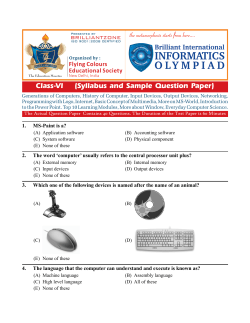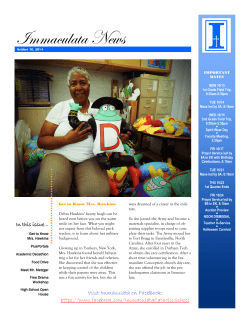
Gender and Livelihoods Impacts of Clean Cookstoves in South Asia
Gender and Livelihoods Impacts of Clean Cookstoves in South Asia Executive Summary COMMISSIONED BY: GLOBAL ALLIANCE FOR CLEAN COOKSTOVES Developed by: Practical Action Lead Contact: Dr. Ewan Bloomfield, Practical Action SUPPORTED BY: GENDER AND LIVELIHOODS IMPACTS OF CLEAN COOKSTOVES IN SOUTH ASIA EXECUTIVE SUMMARY EXECUTIVE SUMMARY “ This research was commissioned by the Alliance to help build a body of evidence around gender, economic empowerment, and livelihoods in the improved cookstove and fuel sectors within South Asia. In South Asia, women play a significant and dominant role within the household cooking sector. Generally women do most of the cooking and, therefore, are disproportionately affected by household air pollution (HAP) caused by the inefficient burning of solid biomass cooking fuels. They are also required to spend a significant amount of time and effort collecting the traditionally used biomass fuels, a physically draining task that can take up to 20 or more hours per week. The governments of India, Nepal, and Bangladesh have recognized that the burning of solid biomass fuels in household kitchens is a significant environmental and health problem in their respective countries and that women can play a key role in efficiently and effectively overcoming this problem. The Global Alliance for Clean Cookstoves (Alliance) has also recognized the central role that women play in meeting its sector-wide target of 100 million households adopting clean and efficient cookstoves and fuels by 2020; and that achieving this goal is dependent on the full inclusion of women throughout the entire value chain. This research was commissioned by the Alliance to help build a body of evidence around gender, economic empowerment, and livelihoods in the improved cookstove and fuel sectors within South Asia. ” key findings On average, women spend approximately 374 hours every year collecting firewood in India. Women with improved cookstoves save 70 hours per year. Female-headed households are more likely to adopt cleaner cooking solutions than maleheaded households. Women who are part of social groups are more likely to own an improved cookstove or use cleaner fuels. Women spend 4 hours every day cooking when using traditional stoves. They can save 1 hour and 10 minutes when using a clean cookstove. Saved time was used to increase involvement in social and family activities, attend community meetings, meet friends and relatives, watch television, and spend time with children and monitor their studies. Households with clean cookstoves reported sending their children to school more often. 3 GENDER AND LIVELIHOODS IMPACTS OF CLEAN COOKSTOVES IN SOUTH ASIA EXECUTIVE SUMMARY Study Objectives and Methodology This study analyzes the gender impacts of clean cooking solutions on households that have adopted them, as well as women’s current and potential involvement in ICS market systems in each of the three South Asian countries. This study focuses primarily on improved biomass cookstoves, but also analyzes the use of other cooking solutions, including kerosene and liquefied petroleum gas (LPG). Efforts have been made to generate recommendations on women’s involvement in ICS value chains that can effectively reach “last mile” households in South Asia. To this aim, surveys were administered in 613 households in Karnataka, Himachal Pradesh, and Odisha states in India using household survey tools. In addition, focus group discussions (FGDs) were carried out in 33 locations with 547 people, as well as key informant interviews and semistructured interviews with 52 people in the 3 locations in India. Detailed literature reviews and key informant surveys were carried out in Nepal and Bangladesh, and workshops were carried out in 5 locations in 3 countries to elicit additional input from relevant local stakeholders. Results The research indicates that, except for a few exceptional cases, the uptake of ICS contributed to fuel saving and the reduction of household air pollution (HAP). This leads to the reduction of drudgery through reduced fuel collection, as well as time saving and health improvements leading to a range of benefits for women. On average there is a 28.1% reduction in firewood consumption due to the use of an ICS compared to a traditional cookstove (TCS). Firewood collection requires significant time, with the TCS user household (HH) spending around 660 hours per year on average for firewood collection compared to 539 hours/ year/HH time by an ICS user household (equating to 122 hours/year/HH of time saving). For firewood collection, there is greater involvement of women as compared to men. On average, in a TCS user household, 56.7% of the time required for fuel collection falls on women, equating to around 374 hours per year, compared to 286 hours for men. However, women who use ICS spend only 305 hours on fuel collection, saving approximately 70 hours per year. cookstoves (ICS and BLEN) was also found to be highest amongst middleincome groups of households followed by the richest household group. The adoption of ICS is significantly higher among women who are members of social groups. Except in a few cases, most users are happy with the performance of the ICS they are using. The research also showed that the main source of information for women on clean cookstoves in the surveyed locations was from government-run ICS projects and non-governmental organization (NGO) staff. In areas where ICS are available, many households were found to still be using TCS; one of the main reasons being the inability of the ICS to meet other all cooking needs, such as cooking with large pots, baking roti bread, drying cereals and meats, etc. Stove stacking was found to be quite prevalent in most regions; many families still use TCS even when they are using LPG or an ICS. The availability of “free” firewood was also found to be a potential barrier to more widespread adoption of clean cookstoves, as households do not directly benefit from fuel purchase savings. In the surveyed locations, the majority (82.8%) of the households collect the required firewood themselves, with about 8.5% collecting as well as purchasing fuels, and only 2% being dependent on purchased firewood only. The surveys included a range of stove types and it was reported that some of the so-called ICS are not performing very well, therefore creating a negative impression of ICS in general. This further highlights the importance of ICS performance testing Despite this success, the acceptance and availability of ICS still remains a significant issue in South Asia. The results also indicate that there is a comparatively higher adoption of ICS and Biogas-LPG-electricity-natural gas (BLEN) stoves by women-headed households compared to men-headed households. Higher adoption of ICS was also found amongst households with a literate head of the household compared to an illiterate head. However, no significant difference in ICS adoption was observed with respect to the education level of the cooks. This indicates that in joint families, women cooks have little role in making decisions with respect to investment in stove and fuels. The use of clean 4 GENDER AND LIVELIHOODS IMPACTS OF CLEAN COOKSTOVES IN SOUTH ASIA EXECUTIVE SUMMARY and tier rating awareness to overcome this issue. Additionally, stronger aftersales services such as warranties and maintenance, and adequate orientation and awareness of users for proper handling of ICS, are also very important to increase household confidence in ICS usage. Gender stereotypes with respect to household tasks and responsibilities was still found to be prevalent; cooking is almost entirely carried out by women, requiring on average about 4 hours a day for cooking using a TCS. There is an average time saving of 30 minutes (12.5%) per day using a biomass ICS and 1 hour 10 minutes (29.2%) per day through a BLEN cookstove. This saved time was found to contribute to women’s increased involvement in social and family activities, including activities to give more time to their children, more time to agricultural activities, attending community meetings, meeting friends and relatives, and other social activities such as watching television while knitting. It was reported that mothers who use ICS are able to devote more time to preparing their children to go to school and monitoring their studies. Likewise, due to the reduced drudgery and time saving, women require less support from their children for household chores and fuel collection. The survey results also report that clean cookstove user households were more likely to send their children to school than TCS user households. Key family finance-related decisions, including purchasing of significant assets and lands, taking out loans, selecting the children’s school, and health treatment expenditure were found to all be made by men. Decisionmaking by women was generally found to be limited to kitchen utensils and what food to cook. A significant difference was also found between the priorities of men and women; ICS and fuels did not fall within the top five priorities of men, while it was only the fifth most important priority of women in the surveyed locations. However, family health was found to be the second most important priority for both men and women, indicating both men and women are worried about the environmental conditions they are living in, but they do not directly relate any health benefits to the increased usage, and resulting improved environmental conditions, of ICS and BLEN. Evidence suggests that there is a need for largescale awareness programs to clearly make the connection between ICS and health benefits for the users. costs and day losses are due to the reduction of chronic illnesses due to long-term reduction to HAP exposure. The use of ICS for a period of only two to three years does not appear to lead to noticeable reduction in chronic illnesses, although this may need to be investigated in more detail. To ensure the development of a vibrant market for a range of technologies it is important to support the entire market system surrounding household cooking technologies. This includes the ICS value chains, the required supporting inputs, services, and finance, as well as the enabling environment factors, which all need to be in place and functional. Broadly, the ICS value chain can be divided into three main models: i) Model 1 – Local on-site construction and installation of ICS ii)Model 2 – National factory produced ICS iii)Model 3 – Internationally produced ICS The health problems reported to be related to HAP included asthma, chronic coughing, severe headaches and fever, eye discomfort, weakness, fatigue, strokes, and heart disease.1 As women, and often small children, have to spend a considerable part of their days in the kitchen, they are the most affected by these ailments. Compared to the TCS users, significantly fewer ICS users reported having respiratory illnesses during the last year, however this did not seem to directly result in any reduction in health expenses and working day losses due to these changes. It is believed that the reduction of health Model 1 ICS market chains in Nepal and Karnataka, India, significantly involve women, but this is not the case in Bangladesh and the Himachal Pradesh and Odisha states of India. Women’s involvement in Models 2 and 3 ICS value chains was found to be very low in all surveyed countries and states of India. Despite the potentially good economic prospects within the sector, the overall involvement of women in ICS value chains is very low due to a number of socio-cultural and economic constraints. Currently, the majority of women lack the skills and flexibility to work in manufacturing and after-sales service of most ICS value 1 http://www.who.int/mediacentre/news/releases/2014/air-pollution/en/ 5 GENDER AND LIVELIHOODS IMPACTS OF CLEAN COOKSTOVES IN SOUTH ASIA EXECUTIVE SUMMARY chains. Women also prefer to work in locations closer to their homes, which is generally not compatible with most ICS companies. Key Recommendations To establish more sustainable ICS markets in the region, there is a need for access to a number of support services, including: i) National cookstove testing protocols, facilities, and quality assurance mechanisms ii)Appropriate design facilities and research iii)Capacity building support iv)Access to finance (for consumers and entrepreneurs) Although there have been efforts to strengthen these services, evidence suggests that they are still not yet at a desirable level to transform the ICS sector in South Asia. While different organizations are carrying out field testing of ICS, there is lack of uniform national testing methodologies. Likewise, there are limited appropriate design facilities and research centers conducting research and development of new cookstove designs. Mostly these services have been limited to donor-led programs and large, multinational private companies. Women’s involvement within these design facilities and research institutions has generally been very limited. As the primary users of cookstoves, women have better knowledge about their needs and should be involved more systematically within the entire market system of ICS. Women’s perspectives could play a central role in product design, quality assurance, research, capacity building activities, and increasing access to finance. barriers to establish a new enterprise to manufacture, distribute, and/or sell ICS, a market almost completely dominated by men in most parts of South Asia. There have been some efforts to build the technical skills of women in ICS production, but it has not included or led to supporting women in establishing new ICS enterprises. To date, there has been a lack of long-term, womenfocused training programs, incubation support to women entrepreneurs, and provision of follow-up services and resources to encourage women to be a part of ICS and fuel value chains. In addition, women entrepreneurs have limited access to finance. Generally, men control the family finances and make decisions regarding the management of assets and land. This lack of asset ownership results in a lack of collateral - one of the more significant obstacles encountered by women entrepreneurs trying to access loans for starting businesses. It is believed that more active engagement of women within ICS and fuel value chains can help generate demand, allow more appropriate products to be designed, and increase their adoption and use. To achieve this, specific gender-sensitive energy interventions and policies should be developed that effectively address women’s basic energy needs and labor activities, as well as the related income, time-saving, and improved health outcomes. In addition, the effective promotion of women within ICS enterprises requires the development of a favorable environment supported by policies, capacity building support, and access to supplier finance. To establish more sustainable markets for clean cookstoves in South Asia with the more active involvement of women, there is a need to remove existing barriers, provide incubation support to women cookstove entrepreneurs, and provide holistic support from, and coordination between, public, private, and civil society organizations throughout the region. Another reason for the low involvement of women within ICS value chains is the absence of well-established and sustainable markets for stoves. In many cases, cookstove production is only carried out informally in South Asia, with ICS production only taking place after an order has been placed, as opposed to production on a regular basis. Consequently, many ICS fabrication units prefer to employ parttime staff, which does not appeal to many women. The research highlights that unless a woman is well-educated, from an urban background, and is mobile (owns and drives a vehicle), she is usually unable to overcome the social constraints and cultural 6 GENDER AND LIVELIHOODS IMPACTS OF CLEAN COOKSTOVES IN SOUTH ASIA EXECUTIVE SUMMARY The Global Alliance for Clean Cookstoves is a public-private partnership hosted by the United Nations Foundation to save lives, improve livelihoods, empower women, and protect the environment by creating a thriving global market for clean and efficient household cooking solutions. The Alliance’s 100 by ’20 goal calls for 100 million households to adopt clean and efficient cookstoves and fuels by 2020. The Alliance is working with its public, private and non-profit partners to accelerate the production, deployment, and use of clean cookstoves and fuels in developing countries. INFO@CLEANCOOKSTOVES.ORG | +1.202.650.5345 | WWW.CLEANCOOKSTOVES.ORG
© Copyright 2025









